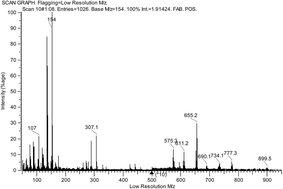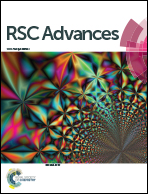Theoretical and experimental investigations on stability and chemistry of organoiridium(iii) complexes†‡
Abstract
Novel iridacyclononanes of the type  {where L = PPh3, PEt3 and P(OMe)3} have been synthesized from their bis(1-pentenyl)iridium(III) precursors through a ring-closing metathesis reaction using Grubbs' 1st generation catalyst. The products were characterized by NMR and mass spectroscopic techniques. The composition and purity of these organoiridium(III) complexes were confirmed by elemental analysis. Various factors, influencing the stability of these complexes, such as the nature of ligand, solvent, and temperature are discussed. The organic product distributions obtained by thermolysis are discussed and compared among the complexes synthesized. The NBO analysis has provided detailed insight into the type of hybridization, nature of bonding in various organoiridium(III) complexes and also the effect of nature of ligand on the stability of these complexes. The highest second order perturbation energies correspond to the maximum delocalization between the donor–acceptor orbitals. The nature of ligand plays an important role in the stability of these complexes due to the varied electronic properties in PEt3, P(OMe)3 and PPh3 ligands, the thermal stability follows the trend: [Cp*IrCl2]2(dppe)] > [Cp*IrR2(PEt3)] > [Cp*IrR2P(OMe)3] > [Cp*IrR2(PPh3)].
{where L = PPh3, PEt3 and P(OMe)3} have been synthesized from their bis(1-pentenyl)iridium(III) precursors through a ring-closing metathesis reaction using Grubbs' 1st generation catalyst. The products were characterized by NMR and mass spectroscopic techniques. The composition and purity of these organoiridium(III) complexes were confirmed by elemental analysis. Various factors, influencing the stability of these complexes, such as the nature of ligand, solvent, and temperature are discussed. The organic product distributions obtained by thermolysis are discussed and compared among the complexes synthesized. The NBO analysis has provided detailed insight into the type of hybridization, nature of bonding in various organoiridium(III) complexes and also the effect of nature of ligand on the stability of these complexes. The highest second order perturbation energies correspond to the maximum delocalization between the donor–acceptor orbitals. The nature of ligand plays an important role in the stability of these complexes due to the varied electronic properties in PEt3, P(OMe)3 and PPh3 ligands, the thermal stability follows the trend: [Cp*IrCl2]2(dppe)] > [Cp*IrR2(PEt3)] > [Cp*IrR2P(OMe)3] > [Cp*IrR2(PPh3)].


 Please wait while we load your content...
Please wait while we load your content...